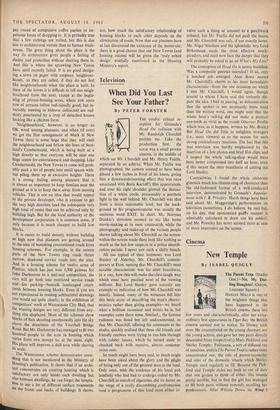Design
New Town Blues
By KENNETH .1. ROBINSON The Ministry's report, which hinted that New Town planners could create better' neighbours by building more compactly and crowding more people on to each acre, said that 'in the experi- ence of all the New To Ain development cor- porations there is a general family preference for a house with a garden—front and back— that gives privacy and room for children to play in safety.' But this statement was out of date * HMSO, 9s. 6d. by the time it was printed. L G. Vincent—who is becoming known as Leonard, doubtless in readiness for his inevitable stardom (look out for some excellent Third Programme talks he has recorded)—has not only experimented with compact building at high densities at Stevenage; he has also lopped off the front gardens, sub- stituted roads to be used only by pedestrians and tested the users' reactions at local meetings. Everyone likes the idea. Similar schemes at Basildon New Town and at housing estates in Coventry and elsewhere have also been very well received. People may be conservative about their living conditions, but they know a really sound plan when they see it. And there is nothing sounder or more likely to be popular than a plan which helps to keep children alive in these days of butchery on the roads.
Apart from the success of schemes like this in preserving life, do they also really help people to live more successfully in each other's lives? The whole question of neighbourliness, its cause and prevention, is as difficult to generalise about as the effect of psychiatric treatment on lonely minds. Anyway, what is .a good neighbour? I remember being horrified, when I was about to move into a Span housing estate, to read a publicity handout promising a lively community life among professional people. To me it sounded like a living death. But although the planning and architecture of the estate is compact and residents live in an apparently friendly way around pleasant courtyards, there is no hideously gay round of compulsive coffee parties or• im- petuous bouts of dropping-in It is probably true that a few etchings are visited, but this is due less to architectural virtues than to human weak- nesses. The great thing about the place is the way its architecture gives people a feeling of shelter and protection without shutting them in. And this is where the sprawling New Towns have until recently failed. It is no good design- ing a town on paper with umpteen 'neighbour- hoods,' as they are called, if they do not feel like neighbourhoods when the place is built. In most of the towns it is difficult to tell one neigh- bourhood from the next, except at the begin- ning of private-housing areas, where row upon row of terraces (often indi vidually good, but in- variably meeting in hideous collisions) are sud- denly punctuated by a crop of detached houses looking like a chicken farm.
'Neighbourhood,' however, is no longer an OK word among planners, and when (if ever) we get the first consignment of Mark II New Towns there is some hope that they will omit the neighbourhood and follow the lines of Scot- land's Cumbernauld, which is being built at a high density so that everyone will be near one huge centre for entertainment and shopping. Like Cumbernauld, the New Towns to come will prob- ably pack a lot of people into small spaces with- out piling them up at excessive heights. There is a strong feeling among planners that it is almost as important to keep families near the ground as it is to keep them away from moving vehicles. This is not an idea that would appeal to the private developer, who is anxious to get the very high densities (and the subsequent very high total of rents) that can be achieved only by building high. But for the local authority or the development corporation it is common sense, if only because it is much cheaper to build low blocks.
It is easier to build densely without building so high now that planners are getting around to the idea of banishing conventional roads from housing schemes. For example, in the newest parts of the New Towns ring roads thrust narrow, dead-end service roads into the sites. And in a housing scheme for twelve acres of Pimlico, which has just won 1,500 guineas for John Darbourne in a national competition, the cars will go both into restricted service roads and--for parking—beneath landscaped court- yards between housing blocks. Even if you are not experienced in reading achitectural drawings you would see quite clearly, in the exhibition of competitors' work at Westminster City Hall, that the winning designs are very different from any- thing else displayed. Most of the schemes show blocks of flats shooting unashamedly into the sky above the dreariness of the Vauxhall Bridge Road. But Mr. Darbourne has managed to fit two hundred people to the acre in housing which varies from two storeys to, at the most, eight. His plans will improve a dull area while sharing its scale.
The Westminster scheme demonstrates some- thing that is not mentioned in the Ministry of Housing's publication. It shows that if an archi- tect concentrates on creating housing which is satisfactory not only inside each dwelling but also between dwellings, he can forget the tempta- tion to use a lot of different surface treatments on the fronts and backs of buildings. It shows, too, how much the satisfactory relationship of housing blocks to each ether depends on the elimination of roads. Now that our planners have at last discovered the existence of the motor-car, there is a good chance that our New Towns (and housing estates) will be given the 'truly urban design' wistfully mentioned in the Housing Ministry's report.































 Previous page
Previous page